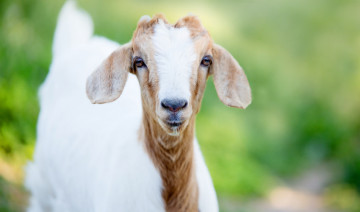
Ketosis in Goats
Ketosis can be a serious condition in pregnant and lactating goats, but can be safely and effectively managed to protect does for a productive and healthy herd. It is important to understand what ketosis is, how it occurs, and how to best keep pregnant goats healthy.
About Ketosis in Goats
Ketosis arises most frequently in pregnant goats. Also called pregnancy toxemia, it is especially prominent in the later stages of pregnancy when the growing fetus compresses the doe’s rumen (stomach), reducing her digestion efficiency and making it harder for her to get the nutrition and energy she needs, just as she needs more energy to nourish her offspring. This is even more common when a doe is pregnant with twins or triplets, which reduces the room in her stomach even further.
When a goat cannot get enough energy from the food she eats, she will instead start to use her own fat reserves for extra energy. Because fat metabolism isn’t as efficient, however, leftover compounds called ketones will start to build up in the goat’s bloodstream. In high concentrations, these ketones are toxic, leading to pregnancy toxemia. Occasionally, this condition will continue even after the kids are born, especially if the doe has trouble producing enough milk for multiple kids. At this point, the ketosis is called lactational ketosis.
Symptoms of ketosis in pregnant and lactating goats include:
- Poor appetite because of the small stomach size
- Rough or dry coat due to poor nutrition
- General apathy, listlessness, and disorientation
- Separation from the herd
- Vision loss, potentially leading to blindness
- Less milk production
- Dry, hard feces or constipation
- Sweet-smelling breath
- Tremors
If left untreated, ketosis in goats can be fatal. In severe cases, it may be necessary to deliver the kids by caesarean section, which can result in the loss of the kids but may save the life of the doe.
Managing Ketosis in Pregnant Goats
Fortunately, ketosis can be effectively managed in pregnant and lactating goats. Feeding the does more grain later in pregnancy as their nutritional needs increase can provide better energy than hay or other high-volume forages. Adding small amounts of corn oil, corn syrup, or molasses to the goat’s feed can also provide more sugar for easily digestible energy, but should be done carefully and with a veterinarian’s guidance. Adding sodium bicarbonate to the feed can also help improve digestion.
Ensuring a doe has an overall healthy pregnancy is a good way to minimize the risk of ketosis. Keeping breeding goats at a healthy weight and preventing obesity in pregnancy is essential, and pregnant does should still have proper exercise, including several hours of roaming time each day.
Reducing stress on pregnant goats can also help the animals better adapt to their changing needs during pregnancy. Be sure breeding does have enough room to feel comfortable, enjoy interaction with the rest of the herd, and have access to plenty of fresh water. Their stall or pen should be kept clean, and there should be adequate air circulation.
With care, even does prone to developing ketosis during pregnancy can be kept healthy and well-nourished during the breeding season, for happy, healthy kids.
